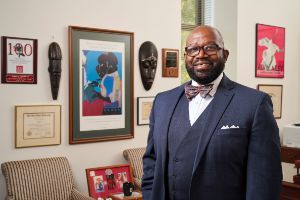lens
Turning National Pain into Purpose
 PHOTO: Roger Mastroianni
PHOTO: Roger MastroianniRobert Solomon
Robert Solomon, JD, had been Case Western Reserve University's vice president for the Office for Inclusion, Diversity and Equal Opportunity less than four months when the killing of George Floyd—seen on video dying under the knee of a Minneapolis police officer—sparked nationwide protests about race, police and justice. Solomon relished the opportunity to help spearhead change. He had to navigate his position not only in an exceptionally intense racial moment, but also during a once-in-a-century pandemic. "It was surreal," said Solomon, who previously served for about 20 years in diversity and inclusion leadership at The Ohio State University. After Floyd's death, Solomon wrote an open letter to the campus. "Let us work shoulder to shoulder to influence this community by asking who is here and who is missing in our student body, faculty and staff," he wrote. "Let us create a climate where everyone feels welcomed, safe and valued."*
I like to observe, survey the lay of the land and then plot my course. It's about building relationships and sometimes having difficult conversations. I like sitting across the table from people to have those conversations [something now limited by the pandemic]. When George Floyd was murdered, I didn't have to contact our president and provost to persuade them [to issue a statement]. We were on the same page. A lot of my colleagues at other universities had to go around in circles trying to convince their senior leadership that they needed to be responsive. [The aftermath] was an incredible balancing of my own feelings and thoughts and frustrations [and], at the same time, I was trying to…provide some leadership to others in the community as they navigated that space as well.
How do you think the current focus on inequality will affect diversity work in higher education nationally?Institutions of higher education are not only being challenged to review their policies and practices that have yielded inequitable results, but there are more people willing to engage in this inquiry. Historically, it has often been dismissed. There are seemingly neutral systems within higher education that are yielding inequitable results in recruitment, hiring, promotion and tenure of faculty, senior leadership, curriculum design, student enrollment, etc. I believe more higher education institutions are prepared to take decisive actions, all because the brutal public execution of George Floyd has moved many from the theoretical notion of racism to the harsh reality of its insidious reach within every facet of society—higher education included.
What are some of your priorities for the Office for Inclusion, Diversity and Equal Opportunity?One of the trainings we do in our office is called 'Interrupting Bias in the Hiring Process.' Anyone who is on a faculty search committee has to go through this training. I'm expanding it to any hiring manager. If you're hiring somebody, then you need to start thinking about the best practices for yielding a diverse pool of applicants. It requires accountability and it requires a commitment. You have to put in the work and the time on the front end of the process, so that we're not at the back end of the process with our hands up in the air saying, 'Well, they [candidates of color] just weren't there.'
*The conversation was edited for length.





